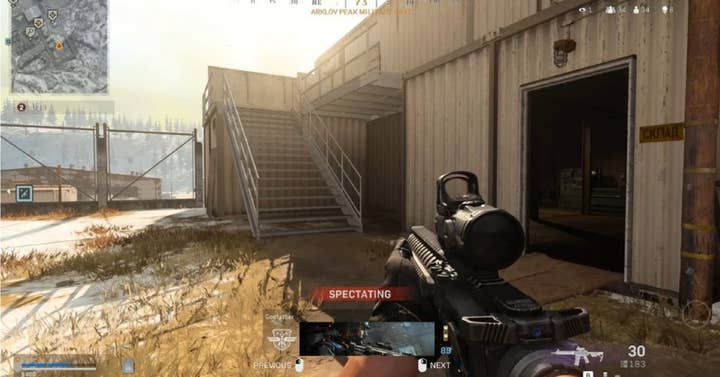The next generation of spectator modes | Opinion
Midia Research's Karol Severin explores ways companies could keep players waiting to respawn engaged with the game, rather than reaching for their phone
The increasing need for digital expression, co-creation, and managing friction in the saturated attention economy presents a lucrative opportunity to bring another in-game experience to the next level: spectating.
Current spectator modes are largely 'waiting rooms' where users take a break while they respawn or try to be helpful to teammates via basic comms if they can.
Next-generation spectator modes will be digital cross-entertainment, social, and commerce destinations. Spectator modes have the opportunity to cater to pre-existing behaviours (e.g. games video viewing, content production and monetisation, in-game item buying, digital socialising etc.) and unlock incremental engagement, revenue potential and positive sentiment in doing so.

The opportunity
No matter how good a game is, gamers will still allocate a share of their entertainment time and money across video, music, sports, fashion, socialising and other components of their cultural identities.
The spectator mode is a point in games where interactivity suddenly drops (e.g. from a highly interactive shooting scene to low interaction waiting period in spectator mode). This gives users great opportunity to multitask or disengage for the sake of doing something else.
The opportunity for spectator modes is to recognise, embrace and cater to those behaviours by building products and features which enable these behaviours in a more user friendly and frictionless manner. The market (and behaviours) already exist. All games companies need to do now is start capturing a part of it.
Let's look at some of the results of Midia's Q4 2020 survey -- specifically, the 4,000 respondents from the US, UK, Canada and Australia. Key areas of this opportunity include:
Games-related video
43% of online multiplayer gamers watch games-related videos every month, compared to 24% of the PC gamer average.
Next-gen spectator modes could enable players to broadcast and monetise their gameplay directly
Gamers currently use the likes of YouTube, Twitch and Facebook Gaming to fulfil their games video consumption and distribution desires. But there are a handful of games companies whose games are being streamed so much, they could capture a part of that engagement (and money) into their own ecosystems.
Next-gen spectator modes could enable players to broadcast and monetise their gameplay directly. Gamers would have access via the spectator mode, where they could follow their favourite players, interact with them and support them financially via tips and donations. Creators could eventually monetise playing with fans in sessions.
To be clear, this is not to suggest that games companies should try to replace YouTube or Twitch -- those will always act as a powerful part of the marketing funnel for the non-owners. Instead, next-gen spectator experiences should be thought of as complementary puzzle pieces to a positive consumer experience.
Spectator modes could provide a distinguished premium video experience for viewers who own the game, providing an additional incentive for non-owners to gain access. Furthermore, a lite version of spectating mode could be made accessible to non-owners (e.g. via mobile) or free version owners, bringing them a step further into the game's ecosystem and encouraging them to upgrade their experience.

In-game spending
Next-gen spectator modes will unlock incremental in-game spending opportunities for games. This includes features like browsing and buying items of spectated players on the fly. At 17%, online multiplayer gamers are more than twice as likely to buy digital in-game items than average PC gamers (8%). Items are just one way of encouraging spending in spectator mode, however.
Subject to geographically nuanced regulations, some games could enable spectators to bet on winners of sessions they are viewing. Online multiplayer gamers are nearly twice as likely to bet on sports (20%) than the PC gamer average (11%). This would be likely done with in-game currencies, rather than real currency.
It is time to stop treating spectator modes as high-school bleachers and waiting rooms, and instead look at them as entertainment venues with the potential of Madison Square Garden
Furthermore, there is a chance to bring in a social aspect to in-game spending in spectator modes. Besides fan-to-player rewards and donations, live auctions could be held on premium experiences while spectating. For example, bidding to be the next to join a player's session. Next-gen spectator modes can bring players and viewers (fans) closer than ever before, because the touchpoint is, well... in the game.
Creator and production tools
We are in the era of 'lean-in', where creation, collaboration and participation are part of the consumption process itself. This is especially pertinent with gamers.
15% of online multiplayer gamers livestream their gameplay every month, compared to 5% of PC gamers and 2% of the all-consumer average. Spectator modes could give enthusiastic creators premium ways of capturing all the amazing scenes that take place on a daily basis in an online multiplayer setting.
Creators should be able to unlock things like premium drone camera tools, lenses, lights and filters, with which they could capture players, and of course distribute and monetise the output. In the future, game streamer experiences could have multiple creator types involved, with the protagonist concentrating on gameplay and narrative, while a 'production team' (creators with in-game drones, etc) focuses on creating the most engaging visual experience possible.
While the immediate opportunities will revolve around livestreaming, spectator modes can open the door for games to eventually become end-to-end facilities for live and scripted digital content production, along with distribution and direct-to-consumer commercial relationships.
Multitasking and 'lean back'-friendly features
Many players simply take their spectator time as a welcome break to engage with something else, be it their social media feeds, checking their favourite sports team scores or simply going to the bathroom. Gamers are doing these things anyway, so for games companies looking for longevity and becoming true cross-entertainment fandom destinations, there are plenty of reasons to embrace these behaviours, rather than fighting against them.

Spectator modes could enable browsing and interacting with the most popular content, which users are most likely to multitask with. This would include third-party content feeds, be it social media, messaging, news, music, and so on. For those who want to keep viewing, but are forced to multitask, spectator modes should become portable/cross-platform (e.g. enabling users to pick up the spectating feed on mobile when they need to move away from the PC or console).
It is apparent gamers use their spectating time in a variety of ways. Sometimes, they will want to lean back and consume content, sometimes they will want to lean forward and shop, while others will want to lean in and create -- and that is precisely the point. Next-gen spectator modes will enable each user to seamlessly double down on what they want to do with their spectator experience each time.
Depending on where each company is in terms of its spectator mode sophistication, achieving a next-gen spectator mode experience may be a timely and costly endeavour for product teams. It is, however, one which will reap significant benefits once established -- and is therefore worth consideration for virtually all online multiplayer games companies.
It is time to stop treating spectator modes as high-school bleachers and waiting rooms, and instead look at them as entertainment venues with the potential of Madison Square Garden.
Karol Severin is lead analyst for research on games at Midia Research.








